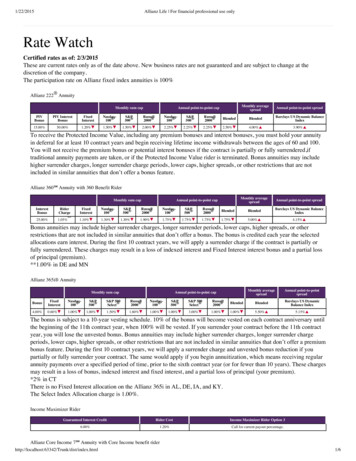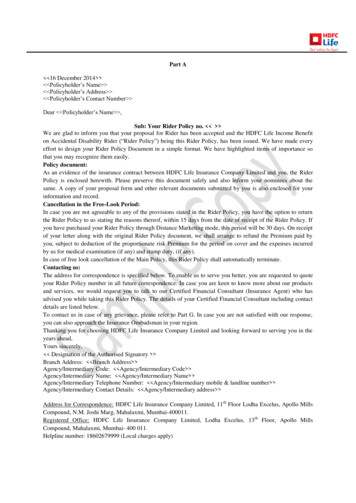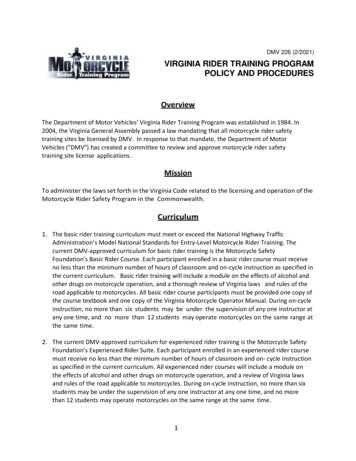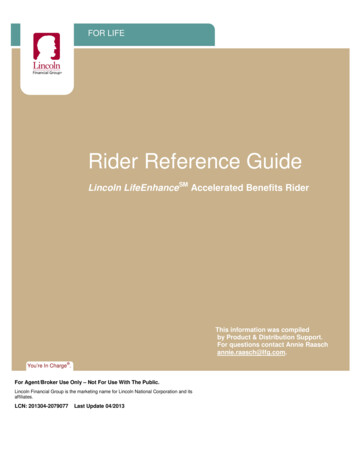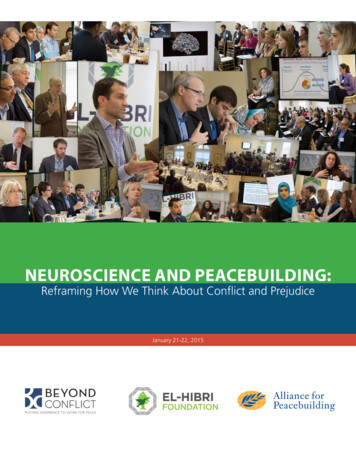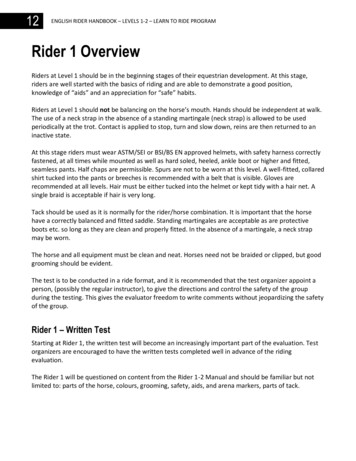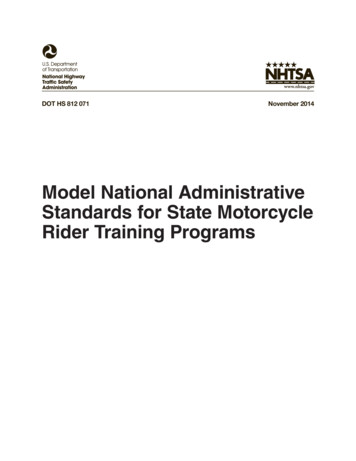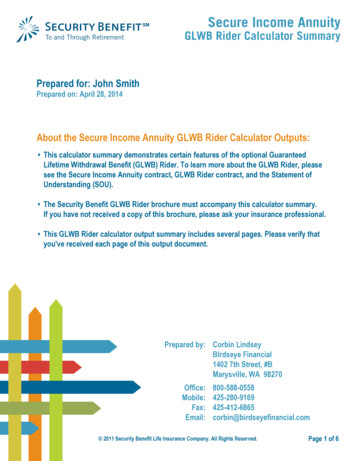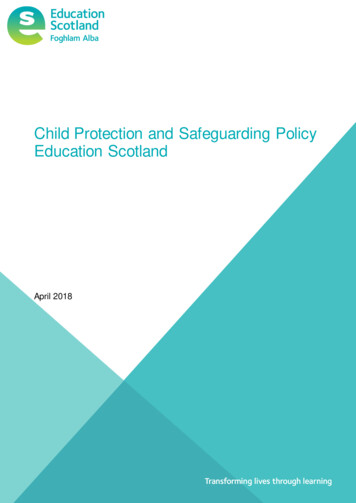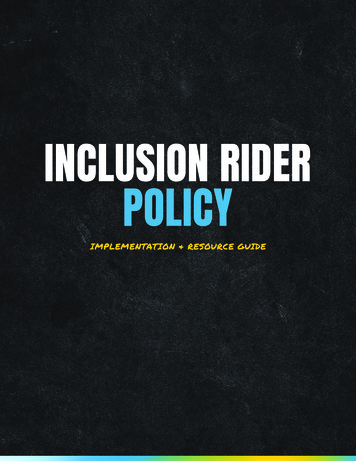
Transcription
INCLUSION RIDERPOLICYIMPLEMENTATION & RESOURCE GUIDE
INTRODUCTIONTHE HISTORY OF EXCLUSION ANDERASURE IN HOLLYWOOD IS LONGAND UNFORGIVABLE.We can break the pattern, and change that trajectory.The understanding of Hollywood’s impact on societyhas never been more widespread, and the demand foraddressing systemic discrimination in Hollywood hasnever been greater. We must answer the call to action.We are calling on the industry to begin tosystematically address inequity and exclusion bydeveloping new standards and practices for hiring withthe adoption of the Inclusion Rider Policy.IMPLEMENTATION &RESOURCE GUIDECONTRIBUTORSKalpana KotagalPartner, Cohen Milstein Sellers & TollFanshen CoxHead of Strategic Outreach, PearlStreet FilmsDr. Tasmin PlaterHead of Human Resources,Endeavor ContentThe Inclusion Rider is an addendum added to acontract that sets forth a process for hiring andcasting to expand and diversify the candidate pool,encourage hiring qualified cast and crew who havebeen traditionally underrepresented in productions,track progress and create accountability. It is a flexibletemplate that should be tailored to particular settingsand productions with the involvement of counsel.Hayley MaconSenior Vice President & Associate GeneralCounsel, Employment - Americas,Endeavor ContentThe Inclusion Rider Policy, is policy meant forcompany-wide adoption that is based on the fouressential principles that define our Inclusion Rider,and without which your policy will not be truly inclusiveor effective: 1) an obligation to deepen and diversifyhiring pool; 2) the need to establish benchmarks andtargets; 3) ways to collect, measure, and analyzecast and crew hiring data; and 4) accountabilitymeasurements that can be implemented if you fallshort of your goals.Rene SpellmanStrategic Advisor, Outlier ProductionsMadhu Goel SouthworthSVP, Legal and Business Affairs,AMC and Sundance TVCaroline JoynerManager, Communications, Color of ChangeRomola RatnamSVP, Social Impact, EndeavorDOWNLOAD RESOURCES2
HOW-TO GUIDEIMPLEMENTATION &RESOURCE GUIDEPURPOSE:To guide you through every step of the Inclusion Rider Policy Implementation & Resource Guide and toprovide you with a roadmap for how you can implement the Inclusion Rider Policy company-wide.IMPLEMENTATION GUIDERESOURCES:Inclusion Rider Policy TemplateThis is a template for facilitating systemic change inhiring, specifically for roles on-camera and behindthe camera.Although the policy is a template, so it is designed tobe altered to fit your specific organization, there arefour components that must be incorporated in yourpolicy in order for it to be classified as Inclusion RiderPolicy. The four components are listed at right.four components in any inclusion rider:DEEP AND DIVERSE HIRING POOL1There must be an initiative to deependiversity in your talent pool.TARGETS/BENCHMARKS2There must be inclusive hiring targets setfor increased representation for both thecast and the crew. These are not quotas.Survey Consent TemplateThe introduction language is the language that isprovided at the beginning of every survey: explainingthe purpose of the survey, confidentiality, and privacystandards; outlining how the data will be used anddestroyed; and offering helpful information regardingresources you can take advantage of for participatingin the survey.Inclusion Rider Policy Survey TemplateThe questionnaire includes a list of questions for youto ask applicants, and cast and crew (once hired), aspart of your data collection process.Data Collection TemplateWhether your data is analyzed internally or externally,in order to provide the data to whomever will beperforming your analytical review, this data templateprovides you with an example of how you can collectyour data.DATA/MEASUREMENTS3ACCOUNTABILITY4There must be a mechanism in placeto measure your interviewing and hiringefforts for key roles on-camera and behindthe camera.If it is determined that the Company hasbeen unable to satisfy the terms of thecommitments made for on-screen and/oroff-screen roles, the Company shall makea meaningful commitment to deepeningdiversity and to advancing content fromindividuals from underrepresented groups.Examples can be found in the FAQs and inthe Inclusion Rider Template.3
HOW-TO GUIDEFAQsImplementationProcess SuggestionsThe FAQs consist of the most commonly askedquestions regarding the Inclusion Rider Policy. Withinthe FAQs, you will also find the following:·····Diverse Hiring Databases: For companies lookingto deepen their talent pool having trouble findingdiverse candidates, we have curated and providedthe links to several databases that specialize inlocating underrepresented talent.·Data Collection & Analysis Experts: Forcompanies seeking advice regarding datacollection, data evaluation, and counsel, we havecurated a list of experts and interested firms withproven success in this area for you to choose from.·Accountability Options: If it is determined thatthe Company has been unable to satisfy the termsof the commitments made for on-screen and/or off-screen roles, the Company shall make ameaningful commitment to deepening diversityand to advancing content from individuals fromunderrepresented groups. Three examples ofhow to proceed if the Company is not reachingits benchmarks or meeting its commitments arebelow, and more can be found in the FAQs:1. A meaningful internal budgetary commitmentfor diversity, equity, inclusion, and accessibility(DEIA) work, including analysis of their slate andpipeline of projects, analysis of their internaldemographics, investment in DEIA leadershipand staff.2. A substantive investment in pipelinedevelopment programs for below-the-line crew.3. A monetary contribution to a 501c3,non-profit whose focus is on investing inunderrepresented talent in Hollywood.IMPLEMENTATION &RESOURCE GUIDE·Review Inclusion Rider PolicyIdentify all of the individuals at yourproduction company and/or studio whoare responsible for hiring, and review theInclusion Rider Policy as a group.Identify which parts of the policy you arecurrently doing, and which parts that needto be implemented.Download the policy template and draftyour version of the Inclusion Rider Policy.Remember, your policy must include thefour main elements: Deep and DiverseHiring Pools, Targets & Benchmarks, Data& Measurements, and Accountability.Once your document is drafted, review itwith your primary stakeholders and beginputting it into practice.Application Process Suggestions···Embed your new Inclusion Rider Policy into yourProduction Handbook.At your production kick-off meeting, review thepolicy with your showrunner/director, line producer/unit production manager, and department headsbefore the start of production.As a group, set your hiring targets and goals for theproduction. Hiring targets can be based on pastperformance, incremental increases by x percentor Census data.4
HOW-TO GUIDE···Create your data collection survey using theprovided survey template.Decide what data you would like to collect. Referto the example questionnaire and Inclusion RiderPolicy Template for guidance.Decide how the data from the cast and crew will becollected. There are several options including:1. Applicants can self-ID before or after theinterview process by way of an anonymous,confidential survey. For companies that arefederal contractors, you are already collectingdata at the applicant stage for race, ethnicity,gender and disability pursuant to OFCCPrequirements. That same infrastructure canbe utilized here. This applicant stage processhas the advantage of guiding the hiringprocess to locate qualified individuals fromunderrepresented backgrounds.2. The production company or studio can send asurvey to all of the applicants after the job hasbeen filled.3. The production company can incorporate aninclusion survey as part of the deal memo andonboarding process.······IMPLEMENTATION &RESOURCE GUIDE4. The production company can send an inclusionsurvey to cast and crew, several times duringthe course of the production.Begin your hiring process. Look to post your roleon public platforms and to leverage inclusivetalent databases.After your hiring process is complete, collect yoursurvey data and house it in a safe place.As a team, decide whether or not you would like toanalyze your data on a per production basis or ona slate basis, for a time span of one year.After that time period has passed, work withwhomever will be looking at your data and analyzeit against your targets.Look for areas of improvement and areas in whichyou performed well, and decide as a team on theareas of focus and the behaviors you need toreplicate in an effort to continue accomplishingyour goals.If you did not achieve your targets, implement oneof the following accountability metrics mentionedearlier in the document, recalibrate as a team, andcontinue moving forward.5
POLICY TEMPLATEIMPLEMENTATION &RESOURCE GUIDEWE AT XYZ STUDIO/PRODUCTION COMPANY RECOGNIZE THE NEED TOINCREASE OUR EFFORTS SO THAT OUR PRODUCTIONS AND THE CONTENTWE CREATE REFLECT THE DIVERSITY IN OUR COMMUNITIES.We understand the importance of increasing representation of people in underrepresented groups,including Black, Indigenous, and non-Black people of color, women of all backgrounds and identities,people with disabilities, people over the age of 40, people from certain religious minorities, and LGBTQ people, in casting, and in hiring behind-the-camera positions.Adopting the Inclusion Rider Policy reflects our commitment to increasing the representation of qualifiedpeople from underrepresented backgrounds in both our cast and crew, when and where possible, in additionto fostering particular attention to those who experience intersectional discrimination, discrimination that is theresult of multiple underrepresented identities, including racism, sexism, colorism, sizeism, ageism, ableism,discrimination for being a member of an underrepresented religious group, or on the basis of sexual orientationor gender identity.Our goal in adopting this policy is to help move the needle forward in diversity, equity, and inclusionthroughout the entertainment industry. In order to do so, our focus will be in four areas, deepening anddiversifying our hiring pools, setting target and benchmarks, ensuring we have a mechanism in placeto measure our hiring data, and implementing means of accountability that we can activate if we don’tsuccessfully accomplish our goals.OUR COMMITMENTAs part of our commitment to the Inclusion Rider Policy, we will do the following:·····Identify an expert, academic, data analyst, or organization, internally or externally, to consult with and/or to evaluate the collection of data and undertake analysis of representation data, essentially performinga full analytical review of our content slate, in the areas outlined below of “On-Screen, Off-Screen, andProduction Company/Studio Positions.”Once an overall slate analysis is complete, we will commit to a cumulative “incremental increase” in ouroverall slate, in each “underrepresented category,” year over year.Make a reasonable effort to ensure that the production creates the opportunity for a meaningfulacknowledgment of Indigenous peoples’ past and present relationship to the land on where activity relatedto the Picture occurs and where the Picture is being filmed.At the earliest stages of production for each studio project, we will bring together decision makers (director,producers, casting director, writers, counsel, experts) for a planning meeting focused on opportunities fordeepening representation on-screen and behind-the-camera, in addition to setting targets/benchmarks forcast and crew diversity.Create and/or advertise our Diversity Value Statement in our production handbook, job postings, andcrew/deal memos and call sheets—and make this Statement accessible to the public via our social mediachannels and website.6
POLICY TEMPLATEIMPLEMENTATION &RESOURCE GUIDEIF A DIVERSITY STATEMENT DOES NOT EXIST, WE WILL CREATE ASTATEMENT THAT INCLUDES THE FOLLOWING:1. A tie to the business’s unique mission to increase representation2. A stated commitment to DEIA3. An expressly mentioned commitment to anti-racism and allyship that pertains to allaspects of the organization4. A commitment to diverse voices as part of your success5. A description of a process for accomplishing these goalsProduction Company & Studio FT Positions:Ensure that open positions are posted to the public and filled with qualified candidates by:···Leveraging our internal job posting platform [IF THIS EXISTS, IF NOT DELETE]; andPosting our open positions on Staff Me Up (SMU) and [OTHER INDUSTRY RELATED JOB POSTINGBOARDS, “AT LEAST A MIN OF ONE JOB POSTING PLATFORM”].For a list of Industry-Related Job Posting Boards and Databases, see Exhibit A: Inclusion RiderDatabase List.on-screen···Before the commencement of the casting process, or as early in that process as is feasible,the Company, Director and/or Casting Director shall consider, in consultation with the Artist (asneeded), where the script presents opportunities for casting individuals from underrepresentedbackgrounds.This audition process should include the good-faith consideration of casting women in rolesscripted for men, or for which gender is unspecified; and an awareness of intersectionaldiscrimination, as described immediately above, and in particular, a deliberate effort to seek outand consider individuals from those groups who have been most marginalized or disadvantaged.The Director and Casting Director will audition a pool of candidates that consists of at least 4050% individuals from underrepresented groups, for all roles.7
POLICY TEMPLATEIMPLEMENTATION &RESOURCE GUIDEOff-Screen (Development, Production, Post-Production):···Before the commencement of the crew hiring process, or as early in that process as is feasible,the Company, and those charged with hiring the crew, in consultation with the Artist (as needed),shall develop a plan to invite individuals from underrepresented backgrounds to seek crewpositions. This may involve outreach to applicable unions and guilds as well as organizationswhose mission involves identifying opportunities for crew from underrepresented backgrounds,and should include a deliberate effort to consider those who have been affected by intersectionaldiscrimination, e.g., Black, Indigenous, or non-Black women of color.The individual(s) responsible for hiring the crew will make best effort to interview individuals fromany underrepresented group for the following positions: Writers & Writers’ Assistants, CastingDirectors, Physical Production Executives and Producers, Art Design & Direction, Directorof Photography/Cinematographer, Production Designer, Sound, 1st Assistant Director, 2ndAssistant Director, Camera Operator, Prop Master, Intimacy Coordinator, Costume Designer, LineProducers, Location Manager, (Unit) Production Manager, Music Supervisor, Composer, Editor,Sound Editor, Key Grip, Gaffer, Post-Production Supervisor, Visual Effects, Script Supervisor,Stunt Coordinator, Makeup Artist, Hair Stylist, Caterer, Colorist, Production Assistant, Marketing,and Public Relations.The interview process should include an awareness of intersectional discrimination, and inparticular, a deliberate effort to seek out and consider individuals from those groups that havebeen most marginalized or disadvantaged.If it is determined that the Company has been unable to satisfy the terms of the commitmentsmade for on-screen and/or off-screen roles, the Company shall make a meaningful contributiontargeted towards the commitment to deepening diversity and to advancing content fromindividuals from underrepresented groups.·Examples of detailed commitments can be found in the Inclusion Rider FAQs and Template.8
SURVEY CONSENT TEMPLATEIMPLEMENTATION &RESOURCE GUIDESurvey Title: Inclusion Initiative SurveyCompany: [Company Name]Email Address and Telephone Number: [Company Email] and [Company Phone Number]You are invited to be part of an INDEPENDENT ANONYMOUS CONFIDENTIAL research initiative, in our effortsto play an active role in ensuring that our workforce reflects the diversity of our communities. The companyconducting this initiative is [COMPANY NAME], in coordination with [XXXX]. The information in this form isprovided to help you decide if you would like to participate. The form describes what you will do during thesurvey and the risks and benefits of the survey. If you have any questions or do not understand something in thisform, please ask the conducting party. You should participate in this survey only after the studio has answeredyour questions and you have decided you would like to be part of this survey.WHAT IS THIS SURVEY ABOUT?We at [XYZ STUDIO/PRODUCTION COMPANY] recognize the need to increase our efforts so that ourproductions and the content we create reflect the diversity in our communities. We understand the importanceof increasing representation of people in underrepresented groups, including Black, Indigenous, and non-Blackpeople of color, people with disabilities, lesbian gay bisexual transgender or queer (LGBTQ ) people, peopleover age 40, or people having a combination of these attributes, in casting, and in hiring behind-the-camerapositions. We believe these efforts will create a stronger pipeline, which will ultimately increase the level ofpeople representation in our industry.HOW MANY PEOPLE WILL BE IN THIS SURVEY?This survey will be offered to every candidate interviewing for the following roles: [LIST POSITIONS]. This surveywill also be used to collect data on current cast and crew.WHO IS PAYING FOR THIS SURVEY?The [Company] is not receiving funds to conduct this survey. This survey is being funded by the [Company].WILL IT COST ANYTHING TO BE IN THIS SURVEY?There is no fee to participate in this survey.HOW LONG DOES THE SURVEY TAKE?If you decide to partake in this survey, your participation will take about 3 minutes.9
SURVEY CONSENT TEMPLATEIMPLEMENTATION &RESOURCE GUIDEWHAT WILL HAPPEN DURING THIS SURVEY?If you decide to be in this survey and if you sign this form, you will be asked to:Share personal information about yourself, including your:······AgeGenderRace, Ethnic Origin, or Tribal AffiliationSexual OrientationGender IdentityDisability StatusWILL BEING IN THIS SURVEY HELP ME?Being a part of this survey will not impact you in the application/selection process in any way. However,information from this survey will shed light on the initiatives studios are taking to increase the number of womenand members of underrepresented groups in our interviewing pipeline.ARE THERE RISKS OF BEING IN THIS SURVEY?It’s always possible that someone’s personal life experience might cause them to react unfavorably to questionsregarding their race, ethnicity, gender, age, disability and sexual orientation/identity. However, the [Company]does not anticipate that any participant will be harmed or distressed during this survey. You may choose to endyour participation in this survey at any time and for any reason. You should be aware, however, of the smallpossibility that your responses could be viewed by unauthorized parties (e.g., computer hackers), because yourresponses will be entered and stored on a web server. Please note, this survey doesn’t solicit this informationre: abuse or self-harm, nonetheless, please note, if this information is revealed, we would have to report it. If youshould need any support due to taking this survey, please contact the Gay, Lesbian, Bisexual, and Transgender(GLBT) National Hotline at 1-888-843-4564, Monday through Friday, between 1pm and 9pm Pacific StandardTime. To report any other survey related issues please call [PROVIDE A REPORT LINE NUMBER].WILL I GET PAID?There will be no form of compensation for the completion of this survey.DO I HAVE TO BE IN THIS SURVEY?Your participation in this survey is voluntary. You can opt out at any time, without risk of penalty. If you would liketo end your participation in this survey, please inform the [ENTERTAINMENT COMPANY].10
SURVEY CONSENT TEMPLATEIMPLEMENTATION &RESOURCE GUIDEWHO WILL USE AND SHARE INFORMATION ABOUT MY PARTICIPATIONIN THIS SURVEY?The [ENTERTAINMENT COMPANY] will not have the ability to capture any information that could match you withyour survey responses The [ENTERTAINMENT COMPANY] understands that conducting this research requiresa high level of professionalism, honesty, and integrity. In regards to the population, the[ENTERTAINMENTCOMPANY] has partnered with [DATA/RESEARCHER FIRM AND/OR INDIVIDUAL] and has taken the necessarymeasures to ensure that the entity upholds the same level of rights for the human subjects involved. The surveycompany fielding this survey follows all national, regional, and local laws with respect to privacy and dataprotection. The guidelines stipulate that:······Panelist cooperation is voluntaryThe identities of studios and respondents are privateThe terms, conditions, and privacy policies are compliant with local lawsState-of-the-art data security policies and measures are usedReliable and validated data procedures are usedThe rules that govern interviewing children and youth are strictly adhered toAll of the market research panel privacy policies are audited and approved by [TRUSTe, the online privacy mark].All of the research activities are opt-in and permission-based. Initial enrollment messaging is clear about thepurpose of the membership, with complete and detailed information provided at the time of enrollment. In anywritten reports or publications, no one will be able to identify any participant.The studio will keep the information you provide in a protected database, maintained and protected by the thirdparty [Research Now. Only the [ENTERTAINMENT COMPANY] and [identified researcher] will have access to thesurvey data. There are no special circumstances as to which data can be used. The only way your data will beconsidered is if you agree to take the survey and fully complete it.Limits of Privacy (Confidentiality)In general, the studio can assure you that what you say or do during the survey will be kept confidential.However, at times, the studio cannot keep things private, including when:···The studio finds out that a child or vulnerable adult has been abusedThe studio finds out that a person plans to hurt him or herselfThe studio finds out that a person plans to hurt someone elseThere are laws that require many professionals to take action if they think a person might harm him or herself, oranother, or if a child or adult is being abused. In addition, there are guidelines that studios must follow to makesure that all people are treated with respect and are kept safe. In most states, there is a government agency thatmust be told if someone is being abused or plans to hurt him or herself, or another. Please ask any questions youmay have about this issue before agreeing to be in this survey. It is important that you do not feel betrayed if thestudio cannot keep something confidential.11
SURVEY CONSENT TEMPLATEIMPLEMENTATION &RESOURCE GUIDEWHO CAN I TALK TO ABOUT THIS SURVEY?At any time, you may ask the studio questions about this survey, or bring up concerns or complaints. Pleasecall the studio using the phone number listed on page 1 of this form if you have questions about the surveyprocedures, survey costs (if any), survey payment (if any), or if you get hurt or sick during the survey.DO YOU WANT TO BE IN THIS SURVEY?By clicking the link below, you agree to the following statement:I have read this form, and I have been able to ask questions about this survey. I voluntarily agree to be in thissurvey. I agree to allow the use and the sharing of my survey-related records as described above. I have notgiven up any of my legal rights as a research participant. I will print a copy of this consent information for myrecords.By clicking the button below, you acknowledge that your participation in the study is voluntary, you are 18 yearsof age, and that you are aware that you may choose to terminate your participation in the study at any time andfor any reason.12
SURVEY TEMPLATE1. Please select the position you’reapplying for:IMPLEMENTATION &RESOURCE GUIDE4. What is your race and/or ethnic origin?Mark all that apply.a. Line Producer/Unit Production Managera. Hispanic, Latino, and/or Spanishb. Director of Photographyb. Caucasian/Whitec. Production Designerc. Middle Easternd. 1st Assistant Director/2nd Assistant Directord. Black, African-American, or other AfricanDescente. Costume Designerf. Editorg. Visual Effects Supervisorh. Composeri.Other: (There should be an open text box herefor people to enter their response)2. Gendere. Asianf. Native Indian of the Americas (including originalpeoples of North, Central, South America)g. Other, including Tribal Affiliation: (Open textbox here for people to enter their response)5. Agea. Malea. 18- 24b. Femaleb. 25- 34c. Non-Binary/Gender-Non-Conformingc. 35- 44d. Other: (There should be an open text box herefor people to enter their response)d. 45- 54e. 55- 646. Disability: (Doyou identify asa person witha disability?)a. Yesb. Nof. 65-743. Do you consider yourself to be:g. 75-84h. 85 a. Heterosexual/Straightb. Lesbianc. Gayd. Bisexuale. Other: (There should be an open text box herefor people to enter their response)3. Are you a veteran?a. Yesb. No13
INTERVIEW DO’S & DON’TSIMPLEMENTATION &RESOURCE GUIDEconsult this document before interviewingConsider developing a list of questions in advance, to use for all applicants seeking a particular sameposition. This practice will help ensure that all are judged by the same standard. It is important to notethat, as part of the application process, candidates will have the option to voluntarily self-ID. This is to bedone through self-ID forms, hiring platforms, or surveys, but NOT in the interview itself.NAMEappropriate“Is there any other name used for workor school that we should know in order tocheck on your work and education record? Ifyes, please provide a list.” This is best askedat point of serious consideration.inappropriateInquiries about the name that would indicateapplicant’s lineage, ancestry, national origin,ethnicity, or descent. Inquiries into previousname of applicant where it has been changedby court order, marriage, or otherwise.MARITAL & FAMILY STATUSappropriateWhether applicant can meet specified workschedules is the only acceptable inquiry.AGE, SEXappropriateFor dates of employment in each job held.Whether the applicant is 18 years old.There should be no questions that relateto sexual orientation.inappropriateAny inquiries regarding an applicant’s dateof birth, age, or sex. Sex is not a bona fideoccupational qualification.RACE, ETHNIC ORIGIN, ANCESTRYappropriateLanguages applicant reads, speaks or writesfluently, if job related only. Must be includedin position description if required.inappropriateinappropriateAny inquiries indicating whether an applicantis married, single, divorced, engaged, dating,has kids, etc.Asking about applicant’s race, color ofapplicant’s skin, eyes, hair, etc., or otherquestions directly or indirectly indicating raceor color. Applicant’s height or weight. Askingabout the applicant’s lineage, ancestry,national origin, descent, ethnicity, parentageor nationality. Birthplace of applicant.Birthplace of applicant’s parents, spouse, orother relatives.14
INTERVIEW DO’S & DON’TSDISABILITYIMPLEMENTATION &RESOURCE GUIDEsample inappropriate questionsappropriateIf applicant indicates that he/she isreasonably able to perform the essentialfunctions of the job and is qualified, thereshould be no inquiry regarding disabilities.inappropriateGeneral inquiries (e.g., “Do you have anydisabilities?”), which would tend to divulgedisabilities or health conditions.SALARYappropriateProvide range of salary expectationsassociate with this role to see if candidateis interested in continuing with theinterview processinappropriateDo not ask about previous salary earningsin previous roles. Are you a US citizen? Do you own your own car/vehicle? Are you single/married? Do you have a disability that might interferewith this job? Do you have children/how many children doyou have/how old are your kids? How many days were you sick last year? How far are you along with your pregnancy/when are you due? In what country were you born? What does your spouse do for a living? I love that accent. Where are you from? Who are you going to vote for in thepresidential election? Is that a (Jewish, Chinese, French, German,etc.) name? Have you ever filed a workers’ compensationclaim/been injured on the job? I noticed you are limping. What happened? Have you ever been arrested? Do you live alone? How much time do you think you will needaway from work after you have your baby? Do you attend church? Are you religious? Are you married to a man or a women?15
INTERVIEW DO’S & DON’TSIMPLEMENTATION &RESOURCE GUIDEgreat interview questionsQuestions related to past jobs: What is the most important accomplishment,achievement or innovation you broughtto your present (past) job? Exactly what were you responsiblefor in your old job? Describe a typical day on the job? Did you ever initiate any changes inthe way the work was performed? What kind of problems did youencounter on your job? How did you solve these problems? What did you like most about your job? What did you like least about your job? What was your reason for leaving?Questions related to motivation: Why did you select this type of work? What do you want to be doingthree years from now? What do you want to be doingten years from now? What do you hope to gain froman organization like ours?Questions related to stability: What was your original career objective? How have your original career planschanged over the years?Questions related to resourcefulness: When you ran into a problem youcoul
Inclusion Rider Policy as a group. · Identify which parts of the policy you are currently doing, and which parts that need to be implemented. · Download the policy template and draft your version of the Inclusion Rider Policy. Remember, your policy must include the four main elements: Deep and Diverse Hiring Pools, Targets & Benchmarks, Data
